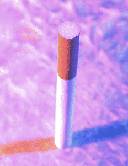- Double Mastectomy May Offer No Survival Benefit to Women With Breast Cancer
- Toxic Lead Found in Cinnamon Product, FDA Says
- Certain Abbott Blood Sugar Monitors May Give Incorrect Readings
- Athletes Can Expect High Ozone, Pollen Counts for Paris Olympics
- Fake Oxycontin Pills Widespread and Potentially Deadly: Report
- Shingles Vaccine Could Lower Dementia Risk
- Your Odds for Accidental Gun Death Rise Greatly in Certain States
- Kids From Poorer Families Less Likely to Survive Cancer
- Tough Workouts Won’t Trigger Cardiac Arrest in Folks With Long QT Syndrome
- At-Home Colon Cancer Test Can Save Lives
Magnetic Brain Stimulation May Help Smokers Quit


TUESDAY, Nov. 12When willpower doesn’t work, smokers who want to quit may have a new tool someday: magnetic brain stimulation.
A study of 115 smokers found that 13 sessions of the treatment over three weeks helped some heavy smokers quit for as long as six months.
This noninvasive technique, called repeated high-frequency transcranial magnetic stimulation, sends electric impulses to the brain. It is sometimes used to treat depression.
“Using noninvasive stimulation can reduce nicotine craving and smoking,” said lead researcher Abraham Zangen, an associate professor at Ben-Gurion University of the Negev in Beer-Sheva.
“If you stimulate regions in the brain that are associated with craving for drugs, you can change the circuitry in the brain that mediates this dependence and eventually reduce smoking,” he said. “And many of those treated stop smoking.”
The study participants smoked at least a pack a day and had failed at least two previous attempts to quit, said Zangen, who has a financial interest in the equipment used in the study.
The researchers divided the participants into three groups. One group received high-frequency brain stimulation, another low-frequency stimulation, and the third received a phony treatment. The groups were further divided into those who saw a visual cue — a picture of a lit cigarette — just before stimulation and those who didn’t.
The idea of the cue is to make sure attention is directed at smoking and not some other craving, Zangen said.
After 13 treatments, those who received the highest level of stimulation plus the visual cue had the best results — 44 percent of them had quit. After six months, one-third of this group were still not smoking compared to 28 percent of those who weren’t shown the visual cue before treatment.
The results of the study were scheduled for presentation Tuesday at the annual meeting of the Society for Neuroscience in San Diego.
Although magnetic brain stimulation is approved by the U.S. Food and Drug Administration for treating depression, it is not yet approved for helping people quit smoking, Zangen said.
Dr. Alan Manevitz, a clinical psychiatrist at Lenox Hill Hospital in New York City, said, “It’s a very effective treatment for depression and anxiety.”
Manevitz thinks using it to help people stop smoking makes sense. Other studies, he noted, have found that stimulating an area of the brain called the insula can reduce the desire to smoke.
“Adding brain stimulation to other smoking cessation methods like nicotine substitution might make it even more effective,” he said.
When used for depression, magnetic brain stimulation costs from $300 to $350 a session, and the treatment may not be covered by insurance, Manevitz said.
For the treatments, participants wear a helmet fitted with coils that deliver magnetic stimulation to the areas of the brain — the prefrontal cortex and the insula — associated with nicotine addiction.
Dan Jacobsen, from the Center for Tobacco Control at North Shore-LIJ Health System in Great Neck, N.Y., thinks the idea is interesting but he doesn’t see this becoming a viable treatment option anytime soon.
“This treatment is not a simple procedure,” he noted. And the six-month results weren’t as good as the success rates for other treatments, including medication and nicotine replacement, combined with behavioral components, he said.
Side effects from the treatment were mild and included headaches or muscle twitching. These symptoms went away with continued treatment, Zangen said. One potentially serious but rare side effect is that brain stimulation can induce a seizure, especially in those prone to epilepsy, he noted.
Data and conclusions presented at meetings are typically considered preliminary until published in a peer-reviewed medical journal.
More information
To find out more about quitting smoking, visit the U.S. Centers for Disease Control and Prevention.
Source: HealthDay
Copyright © 2024 HealthDay. All rights reserved.










